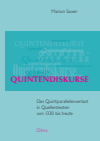Zusammenfassung
Das Quintparallelenverbot ist eine Kontrapunktregel, die heute jeder professionell mit Musik Beschäftigte im Studium kennenlernt. Weniger bekannt ist der Sachverhalt, dass die Regel bereits 1330 erstmals im Kontext einer mündlich geprägten Praxis kontrapunktischen Singens formuliert wurde. Ihre historische Entstehung wurde nicht im kulturellen Gedächtnis europäischer Musik verankert. Der vorliegende Band füllt diese Erinnerungslücke, indem er die annähernd siebenhundertjährige Geschichte des Verbots anhand von sechzehn Quellentexten und ausführlichen musik-, kultur- und medienwissenschaftlich fokussierten Kommentaren präsentiert. Dabei eröffnen sich u.a. überraschende Einblicke in die Hör- und Mediengeschichte der europäischen Musik.
Abstract
The prohibition of fifth parallels is a counterpoint rule that every professional music student learns today. Less well known is the fact that the rule was first formulated as early as 1330 in the context of an oral practice of contrapuntal singing. Its historical emergence was not anchored in the cultural memory of European music. This volume fills this memory gap by presenting the almost seven-hundred-year history of the prohibition on the basis of sixteen source texts and detailed commentaries focussing on musicology, cultural studies and media studies. Among other things, this provides surprising insights into the listening and media history of European music.
Schlagworte
Arnold Schönberg Athanasius Kircher Christiaan Huygens composition Gioseffo Zarlino Guillaume Dufay Johann Mattheson Komposition music theory Musiktheorie Tonsatz Wolfgang Caspar Printz- 11–12 Vorbemerkung 11–12
- 13–28 Einleitung 13–28
- 429–444 Literaturverzeichnis 429–444

